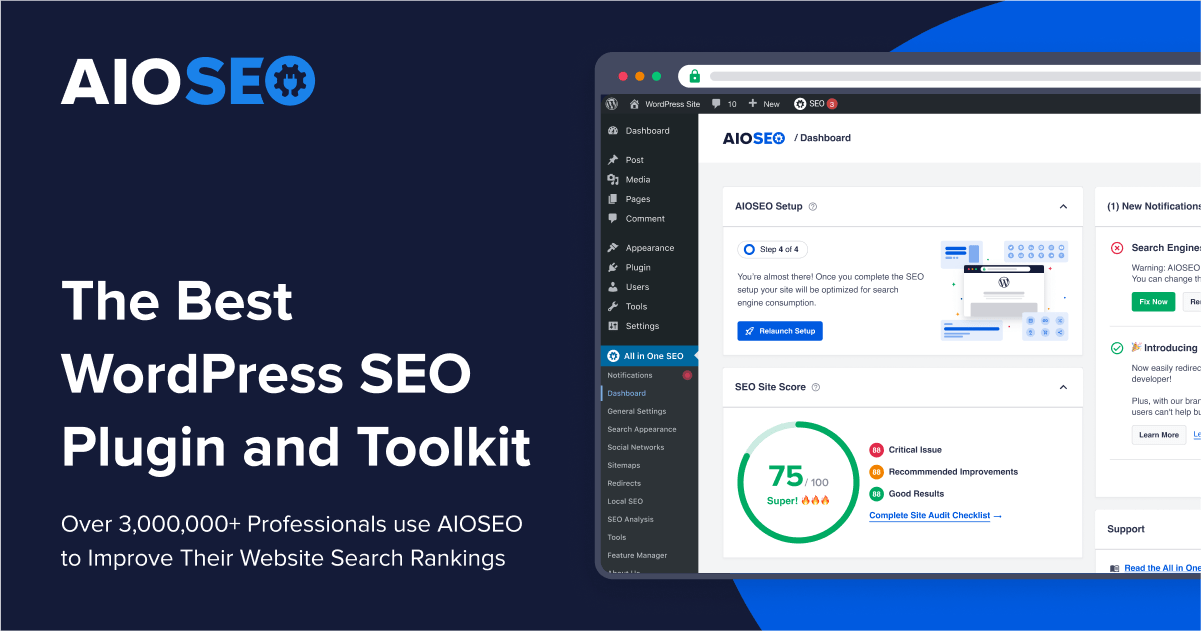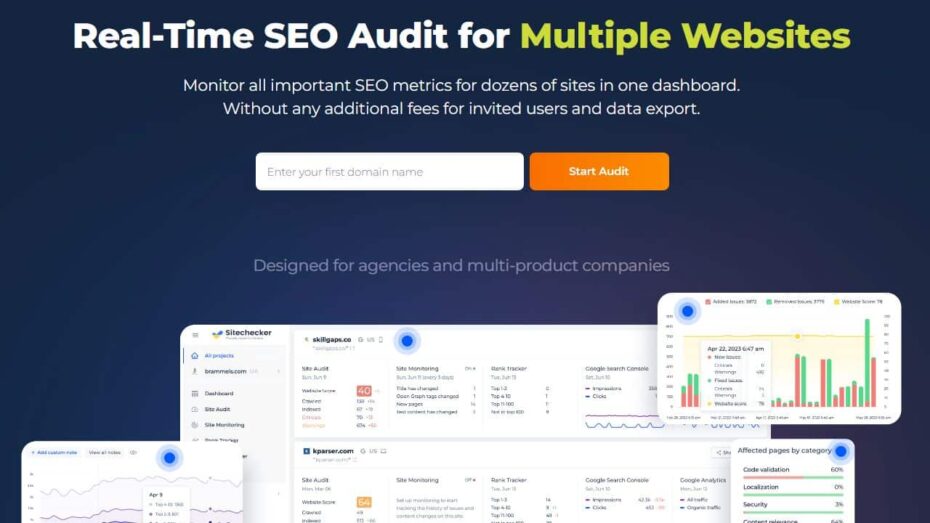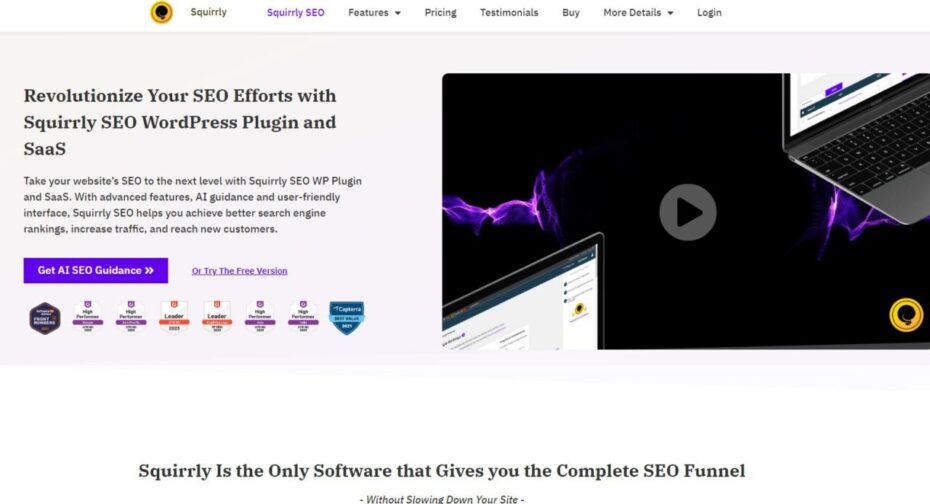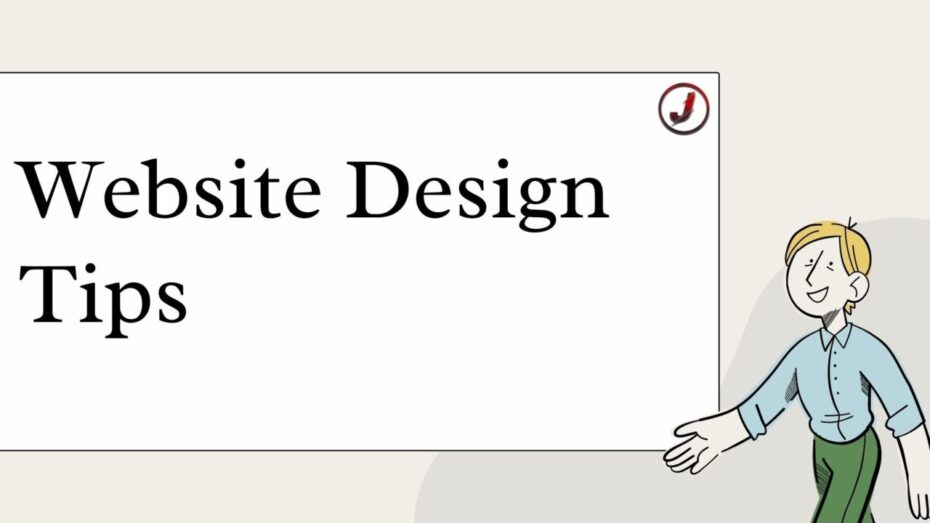Table of Contents
Website design is crucial in increasing user visits to your website. A well-designed website not only attracts visitors but also keeps them engaged and encourages repeat visits. In this article, we will explore various website design tips that can help you boost user engagement and traffic to your site.
Enhance User Experience with Intuitive Navigation
Improving website design involves creating a user-friendly navigation system. When visitors find it easy to explore your website, they are more likely to stay longer and return. This enhances user experience and can significantly increase user visits to your website.
Most importantly, my advice is to focus on making your navigation intuitive. This means that users should be able to find what they are looking for without any confusion. I recommend starting with a simplified menu structure, clear and descriptive labels, and an efficient search bar.
SEO Services Recommendations
 AIOSEO
|  Sitechecker
|  Squirrly
|
Simplify Menu Structure
A simplified menu structure is crucial for good website design. When your menu is straightforward, users can easily navigate through your site, improving their overall experience.
I believe that keeping your menu items to a minimum is essential. Too many options can overwhelm visitors, making it difficult for them to decide where to go next. I suggest categorizing your content into broad sections and using dropdown menus to organize subpages. This way, users can find specific information without feeling lost.
Another point I would emphasize is to place the most important pages at the beginning of the menu. My recommendation is to prioritize pages like Home, About, Services, and Contact. This ensures that visitors can access key information quickly and easily.
Moreover, I advise you to use recognizable icons alongside menu items. Visual cues can help users understand menu options at a glance, making navigation even more intuitive.
Lastly, regularly review and update your menu structure. I strongly believe that continuous improvement based on user feedback and behavior analytics will keep your navigation system user-friendly and efficient.
Use Clear and Descriptive Labels
Using clear and descriptive labels in your website design is essential for intuitive navigation. When labels are easy to understand, users can quickly identify the sections they need, enhancing their overall experience.
I recommend avoiding jargon and using simple language for your labels. Visitors should not need to guess what a menu item means. For instance, instead of using “Our Solutions,” you could label it as “Services” or “Products,” depending on your offerings.
Another suggestion is to make your labels specific. General terms can be confusing, so my advice is to be precise about what users can expect to find. For example, instead of “Learn More,” use “About Us” or “Our Story” to give users a clear idea of the content they will see.
I believe that consistency in labeling is also important. Stick to a consistent naming convention across your website to avoid confusing your visitors. If you use “Blog” in one section, avoid using “Articles” or “News” in another; keep it uniform.
In addition, using action words in labels can be helpful. Phrases like “Get Started” or “Contact Us” guide users on what to do next, making the navigation more intuitive. My suggestion is to think from a user’s perspective and label accordingly.
Implement a Search Bar
Implementing a search bar is a fundamental aspect of good website design. It allows users to quickly find the information they need, which can significantly improve their experience on your site.
I point out that placing the search bar in a prominent location is key. Usually, the top right corner of your website is an ideal spot. Visitors often look there first, so it ensures that the search function is easy to find.
My advice is to make the search bar functional and efficient. This includes implementing autocomplete suggestions and correcting typos automatically. These features can help users find what they are looking for even if they make a mistake while typing.
Another recommendation is to ensure that the search results are relevant. I suggest using filters and categories to refine search results, allowing users to narrow down their options quickly. This way, they can find the specific information they need without scrolling through irrelevant results.
Additionally, I believe that having a search bar on every page is beneficial. This allows users to search for information no matter where they are on your site, enhancing their overall experience.
Finally, analyze search data regularly. By understanding what users are searching for, you can optimize your content and navigation further. This continuous improvement will help in making your website design more user-friendly and effective.
Optimize Website Speed for Better Performance
Website design plays a crucial role in user experience, and one key aspect of this is optimizing website speed. A fast-loading website keeps users engaged and reduces bounce rates, which can ultimately increase user visits to your website.
I believe improving website speed is vital for retaining visitors. Slow websites frustrate users and drive them away. My suggestion is to focus on optimizing various elements of your site to enhance its speed and performance.
Compress Images and Files
Compressing images and files is an effective way to improve website speed. Large files can significantly slow down your site, affecting user experience.
I recommend using image compression tools to reduce the file size without compromising quality. Tools like TinyPNG or JPEG-Optimizer can help in achieving this. By compressing images, you can decrease load times, making your website more efficient.
Another suggestion is to leverage file compression techniques for CSS, JavaScript, and HTML files. Minifying these files removes unnecessary characters and spaces, which can speed up your website. My advice is to use tools like Gzip or Brotli for file compression.
Additionally, I strongly believe that lazy loading images can enhance website speed. This technique loads images only when they are about to appear in the user’s viewport, reducing initial load times. Implementing lazy loading can significantly improve your site’s performance.
Lastly, ensure that your media files are in modern formats like WebP for images and MP4 for videos. These formats offer better compression and faster load times. I advise you to convert your existing media files to these formats to optimize your website speed.
Use a Reliable Hosting Service
Using a reliable hosting service is fundamental to maintaining optimal website speed. A good hosting provider ensures that your website loads quickly and handles traffic efficiently.
I suggest researching and choosing a hosting service with a proven track record of high uptime and fast servers. Providers like Hostinger, Inmotion Hosting, or WP Engine are known for their reliability and speed.
Another recommendation is to consider using a Content Delivery Network (CDN). CDNs distribute your website’s content across multiple servers worldwide, reducing the distance data needs to travel to reach users. This can significantly improve load times for visitors from different geographic locations.
I advise you to regularly monitor your hosting performance. Tools like GTmetrix or Pingdom can help you track your website’s speed and identify any issues with your hosting service. Regular monitoring ensures that your website remains fast and responsive.
Moreover, I recommend opting for managed hosting services if your budget allows. Managed hosting providers take care of server maintenance, security, and updates, allowing you to focus on other aspects of your website design.
Minimize HTTP Requests
Minimizing HTTP requests is another critical factor in speeding up your website. Each request made by the browser to load different elements of a page can slow down your site.
I suggest reducing the number of elements on your pages, such as scripts, images, and stylesheets. Combining multiple CSS and JavaScript files into one can reduce the number of requests, enhancing load times.
My recommendation is to use asynchronous loading for scripts. This allows multiple scripts to load simultaneously, rather than waiting for one to finish before loading the next. This technique can significantly speed up your website.
Additionally, I advise you to leverage browser caching. Caching stores copies of your website’s files on users’ browsers, reducing the need to load them from the server each time. Implementing caching can improve repeat visit load times dramatically.
Lastly, using a tool like Google PageSpeed Insights can help you identify and reduce unnecessary HTTP requests. This tool provides specific recommendations for optimizing your website’s performance, which I believe is invaluable for maintaining a fast-loading site.
Make Your Website Mobile-Friendly
Making your website mobile-friendly is essential in today’s digital landscape. With a significant portion of users accessing websites via mobile devices, a mobile-friendly design ensures that your site is accessible and easy to navigate on smaller screens.
I advise you to prioritize mobile optimization in your website design strategy. A mobile-friendly website can increase user engagement and satisfaction, leading to higher traffic and better search engine rankings.
Use Responsive Design Techniques
Using responsive design techniques is crucial for creating a mobile-friendly website. Responsive design ensures that your website adapts to different screen sizes and devices, providing a seamless user experience.
I recommend using flexible grid layouts that adjust to the screen size. This ensures that content is displayed correctly, regardless of the device being used. My advice is to use CSS media queries to apply different styles based on the screen size.
Another suggestion is to ensure that your images and media elements are responsive. Use CSS to set images to a maximum width of 100%, so they scale down appropriately on smaller screens. This prevents images from breaking the layout on mobile devices.
I believe that using responsive typography is also important. Adjusting font sizes and line heights based on the screen size can improve readability on mobile devices. My recommendation is to use relative units like em or rem for font sizes, allowing them to scale proportionally.
Lastly, test your website on various devices and screen sizes. I advise you to use tools like Google’s Mobile-Friendly Test or BrowserStack to ensure that your website looks and functions well on all devices.
Test on Multiple Devices
Testing your website on multiple devices is essential to ensure a mobile-friendly experience. Different devices can display your website differently, so thorough testing is crucial.
I suggest using emulators and real devices for testing. Emulators like those in Chrome DevTools can simulate various devices, but testing on actual hardware provides a more accurate representation of user experience.
My advice is to focus on popular devices and screen sizes. Analyze your website’s traffic data to identify the most commonly used devices among your users, and prioritize testing on those devices.
Additionally, I recommend testing different functionalities, such as navigation, forms, and media playback, on mobile devices. Ensure that all elements are easy to use and accessible. This includes checking for touch responsiveness and making sure interactive elements are large enough to tap easily.
I strongly believe that performing usability tests with real users can provide valuable insights. Observing how actual users interact with your website on mobile devices can highlight any issues or areas for improvement.
Optimize Touchscreen Navigation
Optimizing touchscreen navigation is a key aspect of mobile-friendly website design. Ensuring that users can easily navigate your site using touch gestures enhances their experience.
I suggest designing larger buttons and touch targets. Small elements can be difficult to tap on touchscreens, leading to frustration. My advice is to use buttons that are at least 44×44 pixels, as recommended by Apple’s Human Interface Guidelines.
Another recommendation is to avoid using hover effects. Hover effects work well on desktops but can be confusing on touchscreens where there is no mouse cursor. Instead, use click or tap events to trigger interactions.
I advise you to implement swipe gestures for navigation. Swipe gestures can make it easier for users to browse through content, especially on mobile devices. For example, allowing users to swipe left or right to navigate between pages or image galleries.
Lastly, ensure that your navigation menus are touch-friendly. Use a mobile menu or hamburger menu that expands to show navigation links. This saves space on smaller screens and makes it easier for users to access different sections of your website.
Focus on High-Quality Content Creation
High-quality content is a cornerstone of effective website design. When your website offers valuable, engaging content, it not only attracts visitors but also encourages them to stay longer and return frequently. This can significantly increase user visits to your website.
I strongly believe that focusing on creating high-quality content will set your website apart from competitors. My advice is to ensure your content is relevant, informative, and engaging, which will resonate with your audience and improve your search engine rankings.
Create Engaging and Relevant Content
Creating engaging and relevant content is crucial for capturing your audience’s attention. When your content speaks directly to the needs and interests of your visitors, it encourages them to explore more of your website.
I recommend starting by understanding your audience. Conduct research to identify their pain points, interests, and preferences. This will help you tailor your content to address their specific needs, making it more engaging and relevant.
Another suggestion is to use a conversational tone in your writing. I advise you to write as if you are speaking directly to your audience. This makes the content more relatable and engaging, which can keep visitors on your site longer.
I believe storytelling is a powerful tool. Incorporating stories or real-life examples can make your content more compelling. My recommendation is to use anecdotes that illustrate your points, helping to create a connection with your readers.
Lastly, ensure your content is easy to read. Use short paragraphs, bullet points, and subheadings to break up the text. I suggest using clear and concise language to make your content accessible to a broader audience.
Use Visuals to Enhance Text
Using visuals to enhance text can significantly improve the appeal of your content. Images, videos, and infographics can make your content more engaging and easier to understand.
My suggestion is to include high-quality images that complement your text. Visuals can break up long blocks of text and provide a visual representation of the information you are conveying. This can help to capture and retain your audience’s attention.
I advise you to use infographics to present complex information. Infographics can simplify data and make it more digestible for your audience. Creating visually appealing infographics can make your content more shareable, increasing its reach and impact.
Another recommendation is to incorporate videos into your content. Videos can explain concepts more effectively than text alone. I believe that creating short, informative videos can enhance the user experience and keep visitors engaged.
Additionally, consider using charts and graphs to support your points. Visual data representation can make your arguments more persuasive. I point out that tools like Canva or Adobe Spark can help you create professional-looking visuals for your website.
Update Content Regularly
Regularly updating your content is essential for maintaining its relevance and effectiveness. Fresh content can improve your website’s search engine rankings and keep your audience engaged.
I advise you to set a content update schedule. Regularly reviewing and refreshing your content ensures that it remains accurate and up-to-date. This can also help to address any changes in your industry or audience preferences.
My recommendation is to use analytics to identify which content performs well and which doesn’t. This can guide your updates, allowing you to focus on improving or expanding popular topics. I suggest adding new information, updating statistics, and refining your content to keep it current.
I believe repurposing old content can be effective. Converting blog posts into videos, infographics, or podcasts can give them new life and reach a different audience. This can also help you get more mileage out of your existing content.
Lastly, I recommend engaging with your audience through comments and feedback. Responding to questions and incorporating feedback can make your content more interactive and valuable. This can also build a sense of community and loyalty among your visitors.
Implement Effective Call-to-Actions (CTAs)
Implementing effective call-to-actions (CTAs) is crucial for guiding visitors toward desired actions on your website. Well-placed and compelling CTAs can significantly increase user engagement and conversions.
I strongly believe that effective CTAs are clear, concise, and persuasive. My advice is to strategically place CTAs throughout your website to encourage visitors to take specific actions, such as signing up for a newsletter or making a purchase.
Place CTAs Strategically
Strategically placing CTAs can enhance their effectiveness. The placement of your CTAs can significantly impact their success in driving user actions.
I recommend placing CTAs above the fold. Visitors should see the CTA without scrolling, which increases the likelihood of engagement. My suggestion is to include a prominent CTA on your homepage and landing pages.
Another suggestion is to use CTAs at the end of blog posts or articles. After reading valuable content, visitors are more likely to take action. I advise you to include CTAs that encourage readers to subscribe, share, or explore related content.
I believe that using inline CTAs within your content can be effective. Embedding CTAs within relevant sections of your text can catch readers’ attention as they engage with your content. My recommendation is to make these CTAs contextually relevant to increase their impact.
Lastly, I advise you to test different CTA placements. Conduct A/B tests to determine which positions yield the best results. This data-driven approach can help you optimize your CTA strategy for maximum effectiveness.
Use Action-Oriented Language
Using action-oriented language in your CTAs can make them more compelling. Strong, clear verbs encourage visitors to take immediate action.
I suggest using verbs like “Get,” “Download,” “Sign Up,” and “Learn More” to prompt action. My advice is to be direct and specific about what you want visitors to do. For example, instead of saying “Click Here,” say “Download Your Free Guide.”
Another recommendation is to create a sense of urgency. Phrases like “Limited Time Offer” or “Act Now” can encourage visitors to take action quickly. I believe that urgency can significantly boost the effectiveness of your CTAs.
I recommend personalizing your CTAs. Using words like “You” or “Your” can make the call-to-action feel more direct and relevant to the visitor. My suggestion is to make visitors feel that the action will benefit them personally.
Additionally, I advise you to highlight the benefits of taking action. Explain what visitors will gain by clicking on the CTA. For instance, “Get Your Free eBook” emphasizes the value the user will receive, making the CTA more attractive.
Make CTAs Stand Out Visually
Making CTAs stand out visually can increase their visibility and effectiveness. A well-designed CTA catches the visitor’s eye and prompts them to take action.
I recommend using contrasting colors for your CTAs. Choose colors that stand out against your website’s background to draw attention. My suggestion is to use bold and vibrant colors that align with your brand identity.
Another suggestion is to use whitespace effectively. Surround your CTA with enough whitespace to make it stand out from other elements on the page. This can help to draw the visitor’s focus to the CTA.
I believe that using large, legible fonts is important. Ensure that your CTA text is easy to read at a glance. My advice is to use a font size and style that makes the CTA prominent and clear.
Lastly, consider using visual cues like arrows or icons to direct attention to your CTA. These elements can guide visitors’ eyes towards the action you want them to take. I advise you to experiment with different design elements to see what works best for your audience.
Improve Website Security to Build Trust
Website design is not only about aesthetics and functionality but also about security. A secure website builds trust with your users, ensuring they feel safe while browsing and interacting with your site. Improving website security can significantly increase user visits and engagement by fostering a sense of reliability.
I strongly believe that focusing on website security is essential for any business. My recommendation is to implement robust security measures to protect your site from potential threats, which will ultimately enhance user confidence and loyalty.
Use SSL Certificates
Using SSL certificates is a fundamental step in securing your website. SSL (Secure Sockets Layer) certificates encrypt the data exchanged between your website and its visitors, ensuring that sensitive information remains private.
I recommend obtaining an SSL certificate from a reputable provider. This will enable HTTPS on your site, indicating to users that your website is secure. Most importantly, an SSL certificate can improve your search engine rankings, as search engines prioritize secure websites.
Another suggestion is to choose the appropriate SSL certificate for your needs. There are various types of SSL certificates, such as single domain, multi-domain, and wildcard certificates. My advice is to select one that best suits your website’s structure and requirements.
I believe that regularly checking the status of your SSL certificate is crucial. Ensure that it is always up-to-date and renew it before it expires. This will prevent any disruptions in your website’s security and maintain user trust.
Lastly, I advise you to display security badges on your website. These badges can reassure visitors that their data is safe, further building their confidence in your site.
Regularly Update Software and Plugins
Regularly updating software and plugins is essential for maintaining website security. Outdated software can have vulnerabilities that hackers exploit, putting your website and users at risk.
I strongly recommend setting a schedule for regular updates. This includes your content management system (CMS), themes, and plugins. Keeping everything up-to-date ensures that you have the latest security patches and features.
Another recommendation is to enable automatic updates where possible. This can save you time and ensure that your software is always current. My suggestion is to use managed hosting services that take care of updates and maintenance for you.
I believe that removing unused plugins and themes is important. These can pose security risks even if they are not active. My advice is to periodically review your website and eliminate any unnecessary components.
Additionally, I suggest using security plugins to monitor your website. Tools like Wordfence or Sucuri can provide real-time protection and alert you to any potential threats. This proactive approach can help you address security issues before they become major problems.
Implement Strong Password Policies
Implementing strong password policies is a simple yet effective way to enhance website security. Weak passwords can be easily cracked, giving unauthorized users access to your site.
I advise you to enforce complex password requirements for all users. This includes a mix of uppercase and lowercase letters, numbers, and special characters. My recommendation is to use passwords that are at least 12 characters long.
Another suggestion is to enable two-factor authentication (2FA). 2FA adds an extra layer of security by requiring a second form of verification, such as a code sent to a mobile device. I believe that this can significantly reduce the risk of unauthorized access.
I recommend regularly updating passwords. Encourage users to change their passwords periodically, and avoid using the same password for multiple accounts. This practice can minimize the impact of any potential security breaches.
Lastly, I suggest educating your users about password security. Provide guidelines and tips on creating strong passwords and protecting their accounts. My advice is to create a dedicated security page or FAQ section to help users understand the importance of strong passwords.
Utilize Analytics to Understand User Behavior
Utilizing analytics is a crucial aspect of effective website design. By understanding user behavior, you can make informed decisions to improve your website’s performance and user experience. Analytics provide valuable insights into how visitors interact with your site, helping you identify areas for improvement.
I strongly believe that leveraging analytics can lead to significant enhancements in user engagement and satisfaction. My recommendation is to regularly analyze your website’s data to gain a deeper understanding of your audience and their preferences.
Track Key Performance Metrics
Tracking key performance metrics is essential for evaluating your website’s success. Metrics such as page views, bounce rate, and average session duration can provide insights into how well your website is performing.
I recommend using tools like Google Analytics to monitor these metrics. This platform offers comprehensive data on various aspects of user behavior. Most importantly, it can help you identify which pages are performing well and which need improvement.
Another suggestion is to set specific goals and track conversions. Whether it’s form submissions, purchases, or newsletter sign-ups, understanding conversion rates can help you assess the effectiveness of your website design and content.
I believe that monitoring traffic sources is crucial. Knowing where your visitors are coming from—whether it’s organic search, social media, or referrals—can inform your marketing strategies. My advice is to focus on channels that drive the most traffic and optimize others to increase their contribution.
Additionally, I advise you to track user demographics and behavior patterns. Understanding the age, location, and interests of your audience can help you tailor your content and design to better meet their needs.
Analyze User Flow and Navigation
Analyzing user flow and navigation can reveal how visitors move through your website. This information is valuable for optimizing your site’s structure and improving user experience.
I recommend using tools like Hotjar or Crazy Egg to visualize user flow. These tools provide heatmaps and session recordings that show where users click, scroll, and spend the most time. My suggestion is to use this data to identify popular pages and optimize underperforming ones.
Another recommendation is to examine drop-off points in your user flow. Identifying where users leave your site can help you understand potential issues. I believe addressing these drop-off points can improve retention and reduce bounce rates.
I advise you to simplify navigation based on user behavior. If analytics show that users struggle to find specific information, consider restructuring your menu or adding clear call-to-actions. My advice is to ensure that important content is easily accessible.
Additionally, I suggest conducting A/B testing to compare different navigation structures. Testing variations can help you determine the most effective layout for guiding users through your website. I strongly believe that continuous testing and optimization are key to improving user flow.
Use Data to Make Informed Design Decisions
Using data to make informed design decisions can significantly enhance your website’s effectiveness. Analytics provide objective insights that can guide your design choices and improve user experience.
I recommend regularly reviewing your website’s performance data. Identify trends and patterns that can inform your design strategy. My suggestion is to focus on metrics that align with your business goals, such as user engagement and conversion rates.
Another suggestion is to prioritize data-driven design changes. Instead of relying on assumptions, use data to identify areas for improvement. I believe that this approach can lead to more effective and user-friendly designs.
I advise you to test design changes before implementing them. Conduct usability tests and gather feedback from real users. My recommendation is to use tools like UserTesting or UsabilityHub to get valuable insights into how users interact with your design.
Lastly, I suggest continuously monitoring the impact of design changes. Use analytics to measure the effectiveness of new designs and iterate based on feedback. I strongly believe that an iterative, data-driven approach is essential for optimizing website design.






